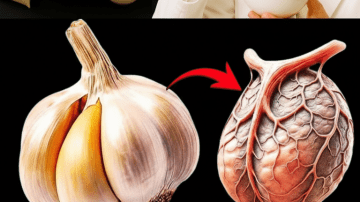🔥 ESCAPING THE DIET FAD MERRY-GO-ROUND
In a world saturated with fleeting superfood trends—from exotic berries to highly processed powders—it is easy to overlook the true nutritional powerhouses that have sustained human vitality for millennia. We chase the quick fix, only to discover that lasting health and energy often reside in the simple, ancestral foods that have stood the test of time. If your current diet leaves you feeling bloated, energy-depleted, or relying on stimulants for sustained focus, your body is quietly crying out for a foundational reset. The key to unlocking this stable, clean energy often means replacing refined, quick-burning carbohydrates with ancient, nutrient-dense staples.
Imagine an ingredient that is mildly sweet, incredibly creamy, inherently gut-friendly, and offers energy that lasts not just an hour, but an entire workday. This treasure is not a newly discovered Amazonian seed; it is Taro (Colocasia esculenta), the purple-flecked, starchy root that is the very cornerstone of cuisine and longevity in tropical regions across Southeast Asia, Africa, and the Pacific Islands. Though it may be a newcomer to your pantry, taro is a reigning champion of nutrition, poised to become the most valuable, versatile superfood in your kitchen.
Taro is far more than just a culinary curiosity. It’s a holistic health package, offering profound, science-backed benefits that range from stabilizing your heart rhythm to fueling your beneficial gut bacteria, strengthening your bones, and providing an unparalleled source of clean, sustainable energy. From digestive comfort to cardiovascular resilience, taro is the underrated secret you are about to discover—a tropical treasure that your body will instantly recognize and love.

🌿 UNVEILING THE TROPICAL POWERHOUSE: WHAT MAKES TARO UNIQUE
Taro, often referred to as “the potato of the tropics,” is the corm (underground stem) of the taro plant. Its appearance is humble, featuring a rough, often hairy brown exterior and a creamy white flesh typically speckled with striking purple fibers.
The Essential Nutritional Distinction:
Unlike many common root vegetables that primarily offer simple starch, taro provides a remarkable profile that prioritizes fiber, complex carbohydrates, and vital micronutrients.
| Key Component | Health Benefit Focus | Impact |
| Fiber | Gut & Metabolic Health | Regulates blood sugar; promotes satiety; aids smooth digestion. |
| Resistant Starch | Prebiotic Function | Feeds beneficial gut flora; acts like soluble fiber but is fermented slowly. |
| Potassium | Cardiovascular System | Balances sodium; helps manage blood pressure and fluid balance. |
| Magnesium & Calcium | Bone & Muscle Integrity | Essential co-factors for maintaining bone density and optimal nerve-muscle function. |
| Vitamin E & C | Antioxidant Defense | Protects cells from oxidative stress and supports immune system function. |
| Complex Carbohydrates | Sustainable Energy | Slow-release fuel source prevents energy spikes and crashes. |
🧠 THE SCIENCE OF SUSTENANCE: TARO’S HEALTH COMMANDMENTS
The traditional diets that rely heavily on taro are often correlated with lower rates of modern metabolic diseases. This is no accident; taro’s structure is purpose-built for human health.
- 🚽 Digestive Resilience and The Gut Microbiome: Taro is an exceptional source of both dietary fiber and, crucially, Resistant Starch. Resistant starch acts as a powerful prebiotic; it passes undigested through the stomach and small intestine, reaching the colon where it becomes the primary fuel source for your beneficial gut bacteria. When these bacteria ferment the resistant starch, they produce Short-Chain Fatty Acids (SCFAs), such as butyrate, which are vital for maintaining the integrity of the colon lining, reducing inflammation, and potentially lowering the risk of colon issues. This is the definition of gut-centered wellness.
- ❤️ The Heartbeat Stabilizer: Taro is a champion of cardiovascular health due to its remarkably high Potassium content and naturally low sodium levels. Potassium is a critical electrolyte that counteracts the negative effects of excess sodium, helping to relax the tension in blood vessel walls. This action directly assists in balancing blood pressure, reducing the overall stress load on the cardiovascular system, and ensuring the heart maintains a healthy rhythm. Furthermore, the high fiber content binds to cholesterol in the digestive tract, facilitating its excretion and supporting healthier lipid profiles.
- ⚡️ Clean, Sustainable Energy: The carbohydrates in taro are primarily complex starches. Unlike refined grains, which are stripped of their fiber and absorbed rapidly (leading to the notorious “sugar rush” and subsequent “crash”), taro digests slowly. This slow breakdown and absorption result in a low glycemic response—meaning a gradual, steady release of glucose into the bloodstream. This makes taro an outstanding, natural fuel source for endurance athletes, for busy professionals needing all-day focus, and for anyone seeking to stabilize blood sugar levels and avoid energy dips.
- 🛡️ Immunity and Oxidative Defense: Taro is rich in essential antioxidants, particularly Vitamin C and Vitamin E. Vitamin C is a powerful water-soluble antioxidant that is necessary for the growth, development, and repair of all body tissues, including the synthesis of collagen, and it actively supports the immune system’s frontline defense. Vitamin E is a crucial fat-soluble antioxidant that protects cell membranes from free-radical damage, reducing oxidative stress—a primary driver of aging and chronic disease.
- 🦴 Architecture for Strength: The structural minerals, Magnesium and Calcium, team up in taro to maintain not just bone density but also critical muscle and nerve function. Magnesium is a cofactor in over 300 enzyme systems that regulate diverse biochemical reactions, including protein synthesis and muscle contraction. Adequate magnesium intake is often linked to better bone health and reduced muscle cramping—especially vital as the body ages and mineral absorption capacity declines.
🍽️ THE CRITICAL RULE: COOKING TARO SAFELY AND SKILLFULLY
Taro, like several other root vegetables, contains calcium oxalate crystals. These microscopic, sharp crystals are the plant’s natural defense mechanism and can cause intense irritation, itching, and burning in the mouth and throat if consumed raw. Therefore, the single most important rule is: Never consume raw taro. Proper cooking methods (boiling, steaming, roasting) completely denature and dissolve these oxalates, making taro safe and delicious.
🛒 Selection and Preparation Mastery:
- Selection: Choose firm, heavy roots that are free of soft spots, blemishes, or mold. Store taro in a cool, dry, dark place, similar to potatoes, but avoid refrigerating raw taro, which can cause chilling injury.
- Peeling Precaution: Calcium oxalates are highly concentrated just beneath the skin. When peeling, many traditional chefs recommend wearing thin kitchen gloves to prevent skin irritation and itching, especially if you have sensitive skin.
- Washing: Always wash the peeled root thoroughly under running water to remove any residual sap or dirt.

🔥 Cooking Methods to Maximize Flavor and Safety:
- Boiling (The Foundation): Cut into uniform cubes and boil vigorously for 15–20 minutes until the cubes are fork-tender. Boiling is the safest, surest method to eliminate oxalates.
- Steaming (The Flavor Preserver): Steaming preserves more of the natural sweetness and yields a firmer texture, often preferred for dishes where the taro needs to hold its shape, such as stews or curries.
- Roasting (The Creamy Texture): Cut the peeled taro into chunks, toss lightly with a high-heat oil (like avocado or coconut), and bake at $200^\circ C$ ($400^\circ F$) for 25–30 minutes until the edges caramelize and the inside is creamy.
🍛 TARO IN THE KITCHEN: VERSATILITY UNLEASHED
Taro’s mild, nutty flavor and uniquely creamy consistency make it an incredibly flexible ingredient, easily replacing potatoes or other starches in almost any cuisine.
- The Comfort Food Upgrade: Create a Creamy Taro Mash by boiling the cubes, then blending them with a splash of plant-based milk (like coconut or cashew milk) and a pinch of salt. It offers a deeper, more complex flavor than standard potato mash.
- Curries and Stews: Taro thickens and enriches liquid-based dishes beautifully. It absorbs the spices and adds a comforting, velvety body to coconut milk curries and hearty vegetable stews.
- The Healthy Snack: Slice the taro roots ultra-thinly using a mandoline, bake or air-fry them until crisp, and season with sea salt and rosemary for wholesome, flavorful Taro Chips.
- Sweet Treats: Its natural sweetness makes taro ideal for desserts. Blend cooked, cooled taro into smoothies (it provides a vibrant purple hue), or mix it with coconut cream and honey for a natural, nutrient-dense pudding.
⚠️ COMMON PITFALLS: AVOIDING THE MISTAKES
To fully reap the benefits of taro, be mindful of these common errors:
- Ignoring the Raw Rule: Never taste or consume raw taro, even small amounts can cause irritation.
- Inadequate Cleaning: Failure to properly wash and peel the taro can leave residual irritants or dirt on the final product.
- Dietary Imbalance: While rich in fiber, overconsumption of any single high-fiber food can lead to bloating, gas, or digestive discomfort. Always balance taro with lean proteins and a wide variety of colorful, non-starchy vegetables.
- Oxalate Sensitivity: While cooking eliminates most oxalates, individuals prone to kidney stones should moderate their intake of oxalate-rich foods, including taro, and always consult a physician for personalized dietary advice.
🧘 MAXIMIZING WELLNESS: TARO IN A HOLISTIC CONTEXT
Taro is most beneficial when integrated into a lifestyle that supports overall vitality.
- Hydration is Key: The high fiber and resistant starch in taro require adequate hydration to move smoothly through the digestive system. Aim for 8–10 glasses of water daily.
- Balance Macros: Pair taro with a lean protein source (fish, poultry, beans) and a high volume of brightly colored, low-starch vegetables (broccoli, bell peppers, leafy greens). This creates a complete meal that maximizes nutrient absorption and metabolic balance.
- Movement: Light, consistent exercise stimulates digestion, enhances nutrient uptake, and helps manage blood sugar—all of which complement the slow-releasing energy of taro.
- Sleep: Prioritize 7–9 hours of quality sleep. Recovery is when the body utilizes the nutrients from taro for cell repair, bone maintenance, and hormone regulation.

🌺 FINAL VERDICT: THE FUTURE OF HEALTHY CARBS
Taro isn’t a temporary health fad; it’s an ancient, sustainable source of fundamental nutrition designed for long-term well-being. It is a highly potent ally for anyone looking to improve gut health, stabilize blood sugar, protect their heart, and fuel their body with clean, crash-free energy.
By understanding its simple preparation requirement and embracing its culinary flexibility, you can effortlessly elevate your meals. So, the next time you are searching for a high-impact, low-maintenance food to boost your health and culinary repertoire, skip the supplements and head straight for this tropical treasure. Grab a few taro roots—roast them, mash them, or blend them—and watch how one humble, purple-flecked root can bring both profound flavor and foundational wellness straight to your plate and into your life.






